The Horned Grebe (Podiceps auritus), a striking waterbird, captivates observers with its unique characteristics and vibrant appearance.
Named for the conspicuous “horns” or golden plumes adorning its head during the breeding season, this medium-sized grebe is a species of great intrigue in avian circles.
Found across Eurasia, North America, and Asia, the Horned Grebe showcases remarkable adaptability, thriving in diverse freshwater habitats.
Its distinctive red eyes, striking black and white plumage, and agile diving abilities set it apart in both appearance and behavior.
Nesting in floating platforms anchored to emergent vegetation, Horned Grebes exhibit collaborative parental care.
As nomadic migrants, they navigate between breeding and wintering grounds, adding another layer to their dynamic life history.
The Horned Grebe’s presence in aquatic ecosystems not only contributes to the delicate balance of nature but also offers bird enthusiasts a captivating subject for observation and study. Stay sharp.
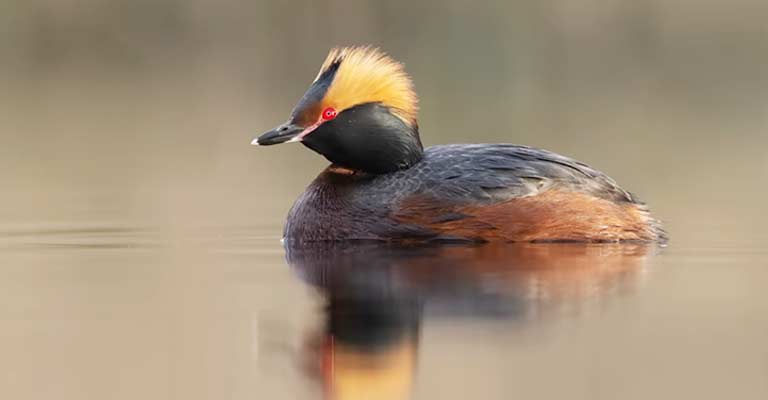
Identifying Characteristics of Horned Grebe
The Horned Grebe (Podiceps auritus), a striking waterbird found in North America, Europe, and Asia, boasts distinctive features that make it easily identifiable.
Whether you’re an avid birdwatcher or a casual observer, recognizing these key characteristics can enhance your birding experience.
Plumage and Size
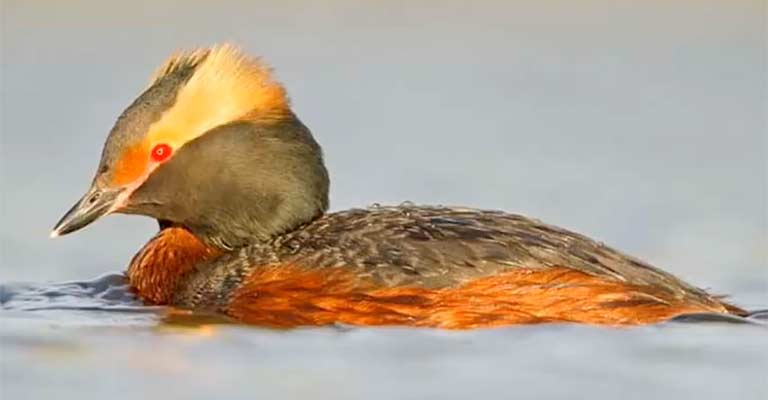
The Horned Grebe is a medium-sized bird, measuring about 13 to 17 inches in length. During the breeding season, its plumage undergoes a remarkable transformation.
The bird dons a striking black crown adorned with conspicuous golden plumes, hence the name “Horned” Grebe. The rest of its body exhibits a mix of black and white feathers, creating a bold and contrasting appearance.
Facial Markings’
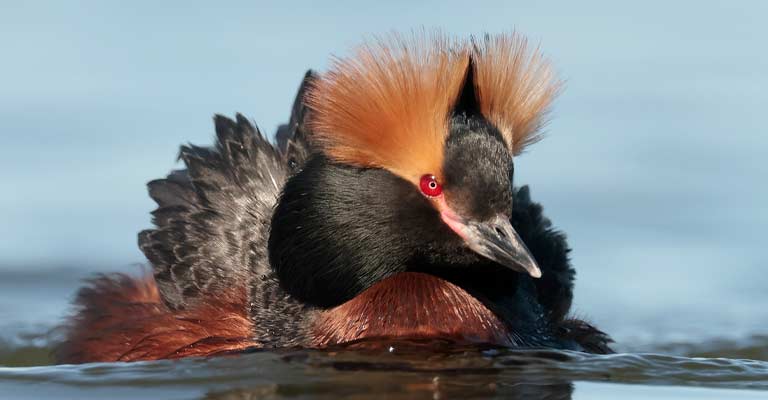
One of the most identifiable features of the Horned Grebe is its distinctive facial pattern.
It sports bright red eyes, a black throat, and a distinctive white cheek patch. This combination of colors creates a visually striking face, making it stand out even from a distance.
Bill Shape
The bird’s bill is relatively short and pointed, distinguishing it from other grebe species. During the breeding season, the bill takes on a rich reddish hue, adding to the bird’s overall vibrant appearance.
Breeding Plumage
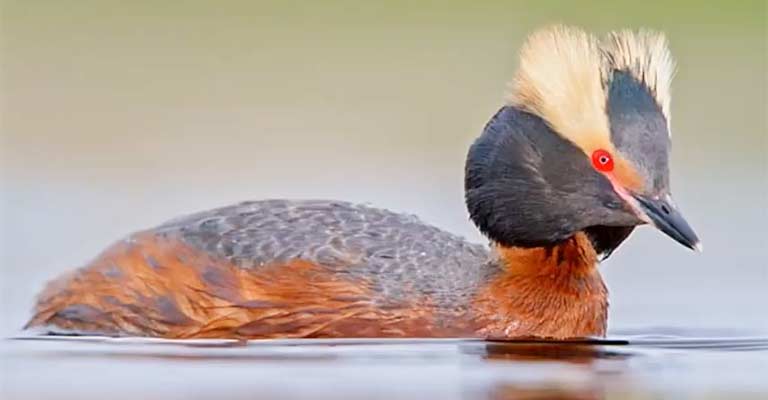
To differentiate the Horned Grebe during its breeding season, look for the “horns” or tufts of golden feathers that extend from the sides of its head.
These ornamental plumes, along with the black crown, are unique to this species during the breeding period.
Non-breeding Plumage
Outside of the breeding season, the Horned Grebe undergoes a molt, transitioning to a more subdued winter plumage.
The distinct facial markings and “horns” are less pronounced, and the overall coloration becomes more muted, featuring shades of gray and white.
Courtship Displays
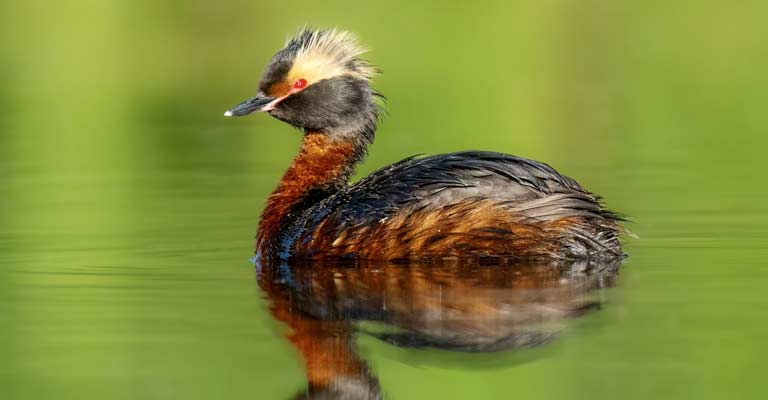
During courtship rituals, Horned Grebes engage in elaborate displays. These may involve synchronized swimming, head shaking, and even exchanging offerings of aquatic vegetation.
Observing these behaviors can confirm the bird’s identity, especially during the breeding season.
Habitat Preferences
Horned Grebes are commonly found in freshwater habitats such as lakes, ponds, and marshes.
They prefer areas with emergent vegetation for nesting and open water for foraging. Identifying their habitat can be a valuable clue when attempting to spot this species.
Distinctive Silhouette
In flight, the Horned Grebe exhibits a distinct silhouette. Its neck is held straight, and its pointed bill is often visible.
The bird’s overall shape, combined with its unique plumage, helps differentiate it from other waterfowl.
Recognizing the Horned Grebe involves a careful observation of its plumage, facial markings, bill shape, and behavior.
By familiarizing yourself with these eight key characteristics, you’ll enhance your ability to identify and appreciate this captivating waterbird in various natural settings.
Taxonomical details of Horned Grebe
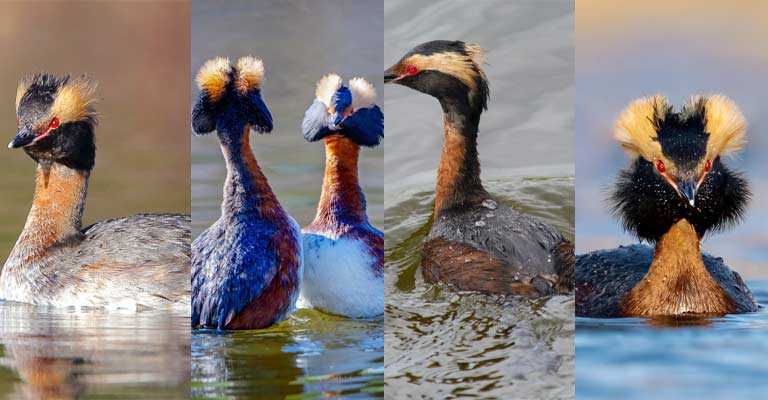
The table below will tell you everything about the taxonomy details of the Horned Grebe:
| Taxonomic Rank | Classification |
| Domain | Eukaryota |
| Kingdom | Animalia |
| Phylum | Chordata |
| Class | Aves |
| Order | Podicipediformes |
| Family | Podicipedidae |
| Genus | Podiceps |
| Species | P. auritus |
The Horned Grebe (Podiceps auritus) is a fascinating bird species with distinct subspecies, each showcasing unique characteristics across different regions.
The two recognized subspecies are P. a. auritus, found in Eurasia, and P. a. cornutus, residing in North America.
- P. a. auritus (Eurasia): In Eurasia, the Horned Grebe’s subspecies P. a. auritus is characterized by its adaptation to the diverse environments of the continent. With a habitat range extending from Northern Europe to Siberia, these grebes display variations in behavior and plumage to suit the conditions of their Eurasian homes. Birdwatchers in this region may observe the Horned Grebe’s distinctive breeding displays, showcasing the remarkable adaptations developed over generations.
- P. a. cornutus (North America): On the North American front, the subspecies P. a. cornutus exhibits its own set of adaptations. From the boreal forests of Canada to the marshes of the United States, these Horned Grebes have evolved to thrive in the specific conditions of the North American continent. Observers may note variations in nesting habits, migration patterns, and possibly subtle differences in plumage that distinguish the North American subspecies from its Eurasian counterpart.
Understanding the nuances of these subspecies enriches our appreciation for the Horned Grebe’s adaptability and the intricate interplay between environment and evolution across different geographic regions.
Hunting Habit of Horned Grebe
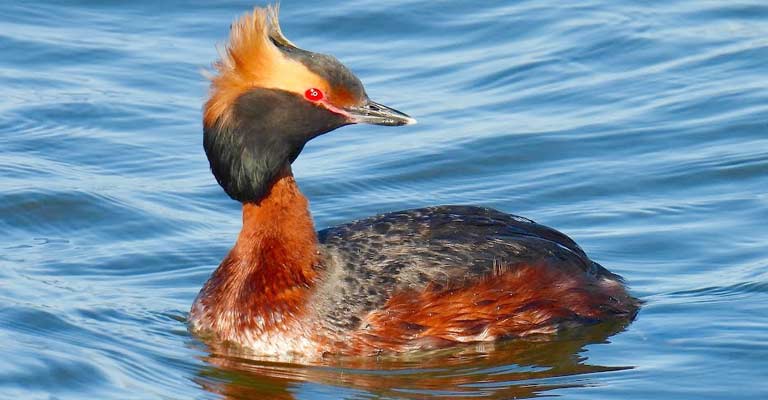
The Horned Grebe is an adept and agile hunter, primarily relying on its exceptional swimming and diving abilities to secure its prey.
With a diet consisting mainly of small fish, crustaceans, and aquatic insects, this waterbird adeptly dives beneath the water’s surface in pursuit of its quarry.
Using its streamlined body and powerful webbed feet, the Horned Grebe propels itself underwater, reaching depths of up to 20 feet. Its sharp, pointed bill is a formidable tool for grasping and capturing prey.
Unlike some other diving birds, the Horned Grebe is known for its ability to feed both during the day and night.
This adaptability, combined with its skilled hunting techniques, allows the Horned Grebe to thrive in a variety of freshwater habitats, showcasing its remarkable prowess as a successful aquatic predator.
Horned Grebe Life History
The Horned Grebe (Podiceps auritus), a captivating waterbird with striking breeding plumage, boasts a fascinating life history.
From its feeding habits to breeding rituals and conservation status, each aspect provides a glimpse into the survival strategies of this species.
Food
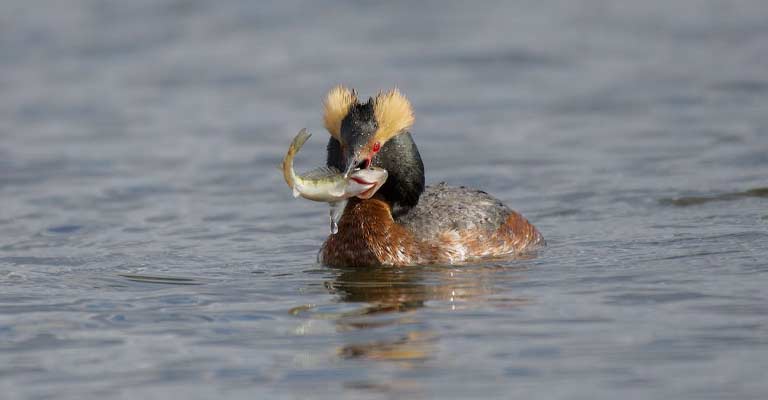
Horned Grebes primarily feed on a diverse diet of small fish, crustaceans, and aquatic insects. Their adept diving skills, facilitated by a streamlined body and powerful webbed feet, enable them to hunt underwater.
This piscivorous diet ensures a critical link in the aquatic food chain, contributing to the ecological balance of their habitats.
Habitat
These grebes favor freshwater habitats such as lakes, ponds, and marshes. They seek areas with emergent vegetation for nesting and open water for foraging.
Their adaptability allows them to thrive in diverse environments, from coastal bays to inland lakes, showcasing their ability to inhabit a wide range of ecosystems.
Range Map
The Horned Grebe exhibits a vast distribution across North America, Europe, and Asia.
A range map illustrates their migratory patterns, with breeding grounds in northern regions and migration to more temperate zones during winter.
This nomadic lifestyle underscores the species’ resilience and adaptability to varying environmental conditions.
Breeding
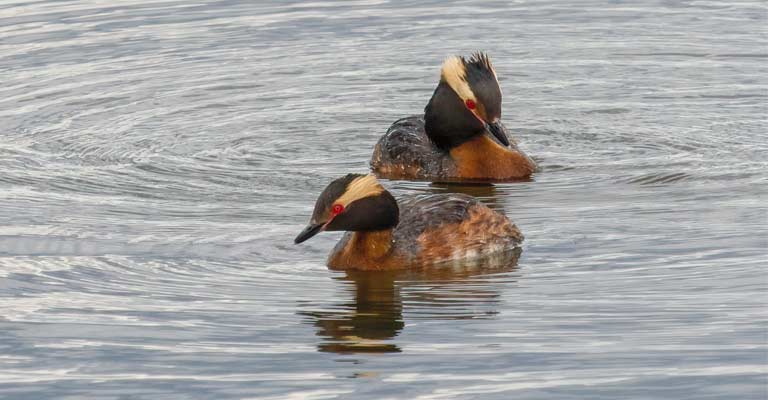
During the breeding season, Horned Grebes undergo a spectacular transformation in plumage.
The distinctive “horns” or golden plumes, along with courtship displays involving synchronized swimming and head shaking, characterize this period.
Nests, constructed from aquatic vegetation, are strategically placed in emergent vegetation, providing a haven for their offspring.
Diseases
Horned Grebes, like many waterbirds, are susceptible to various diseases. Avian botulism, commonly found in aquatic environments, poses a threat to their populations.
This neurotoxic illness can result from ingesting contaminated prey. Monitoring and understanding disease dynamics are crucial for effective conservation measures.
Treatment
In cases of disease outbreaks, interventions such as habitat management, water quality improvement, and monitoring for early signs of illness are vital.
Conservation efforts may include rehabilitation programs for affected individuals, emphasizing the interconnectedness between the health of the Horned Grebe population and the overall well-being of their habitats.
Conservation
The Horned Grebe faces conservation challenges due to habitat degradation, pollution, and climate change.
Protection of breeding sites, preservation of critical wetland habitats, and international cooperation are essential for ensuring the long-term survival of this species.
Conservation initiatives play a pivotal role in safeguarding the Horned Grebe and the delicate ecosystems it inhabits.
The life history of the Horned Grebe is a testament to its resilience and adaptability.
From its diverse diet and breeding rituals to the challenges it faces and the conservation efforts required for its survival, understanding the intricacies of the Horned Grebe’s life history contributes to the broader tapestry of avian ecology and conservation.
Nesting Habit of Horned Grebe
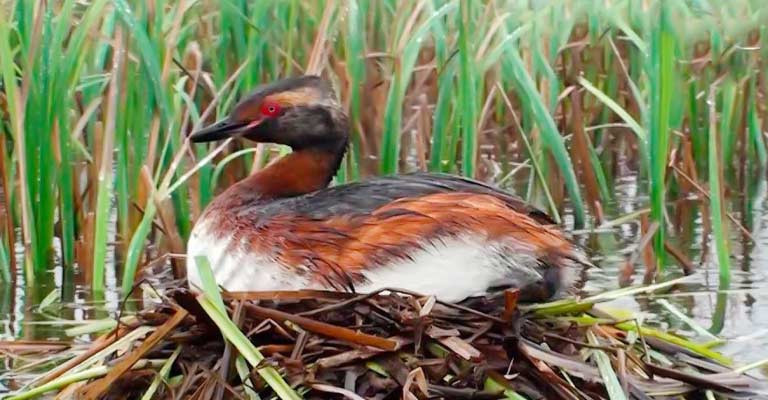
Here’s a table summarizing the nesting details of the Horned Grebe:
| Nesting Details | Facts |
| Clutch Size | 3 to 5 eggs |
| Number of Broods | Usually 1 per breeding season |
| Egg Length | Approximately 1.6 to 1.8 inches |
| Egg Width | Around 1.1 inches |
| Incubation Period | About 23 to 29 days |
| Nestling Period | 1 to 2 days |
| Egg Description | Oval-shaped, smooth surface, pale bluish-green to olive-colored with darker spots and speckles |
| Nest Type | Floating platform nest, often anchored to emergent vegetation |
| Nest Material | Constructed from aquatic vegetation, reeds, and other plant matter |
| Nest Location | Placed in shallow water amidst emergent vegetation |
| Incubation Responsibility | Shared by both male and female |
| Parental Care | Both parents involved in caring for and feeding the young |
Understanding these nesting details provides insights into the reproductive strategies and adaptations of the Horned Grebe during the crucial breeding season.
10 Surprising Facts About Horned Grebe
The Horned Grebe (Podiceps auritus) is a remarkable waterbird that often surprises observers with its unique characteristics and behaviors.
From its captivating appearance during the breeding season to its fascinating habits, here are 10 surprising facts that make the Horned Grebe a standout species in the avian world.
- Breeding Plumage Transformation: Perhaps one of the most surprising features of the Horned Grebe is its dramatic change in appearance during the breeding season. The bird develops distinctive golden plumes on its head, colloquially known as “horns,” adding a regal and surprising touch to its overall look.
- Nomadic Migrations: Horned Grebes are known for their extensive migrations. Breeding in northern regions, these birds migrate to more temperate zones during the winter. Their nomadic lifestyle highlights their adaptability to diverse environmental conditions.
- Aquatic Acrobat: As adept divers, Horned Grebes showcase their aquatic acrobatics while foraging. Using their streamlined bodies and powerful webbed feet, they propel themselves underwater, reaching impressive depths of up to 20 feet in search of prey.
- Unique Courtship Displays: During courtship rituals, Horned Grebes engage in elaborate displays, including synchronized swimming, head shaking, and exchanging offerings of aquatic vegetation. These behaviors showcase the bird’s social and courtship intricacies.
- Floating Nests: The nesting habits of Horned Grebes are equally surprising. They construct floating nests anchored to emergent vegetation, providing a safe and strategic location for their eggs amidst shallow waters.
- Egg Coloration: The eggs of Horned Grebes are a visual delight. Oval-shaped and ranging in color from pale bluish-green to olive, they are adorned with darker spots and speckles, contributing to the species’ overall aesthetic appeal.
- Parental Responsibility: Both male and female Horned Grebes actively participate in incubating the eggs and caring for the young. This shared parental responsibility is not only surprising but also emphasizes the collaborative nature of their breeding dynamics.
- Diving at Night: Unlike some diving birds, Horned Grebes are known to feed both during the day and night. This nocturnal foraging behavior adds an unexpected layer to their hunting habits, showcasing their adaptability.
- Brief Nestling Period: The nestling period of Horned Grebes is relatively short, lasting only 1 to 2 days. This rapid transition from nest to independence underscores the species’ efficiency in preparing the young for their aquatic life.
- Conservation Challenges: Despite their resilience, Horned Grebes face conservation challenges, including habitat degradation and pollution. The surprising fact lies in the crucial role that conservation efforts play in ensuring the long-term survival of this captivating waterbird.
The Horned Grebe’s surprising facts enrich our understanding of its biology, behavior, and the conservation efforts needed to protect this remarkable species in our diverse ecosystems.
Wrapping Up
In the intricate tapestry of avian life, the Horned Grebe stands out with its surprising plumage, nomadic migrations, and acrobatic behaviors.
From its floating nests to shared parental duties, this waterbird’s unique traits underscore the importance of conservation efforts in preserving its captivating existence amidst evolving environmental challenges. Thank you so much.